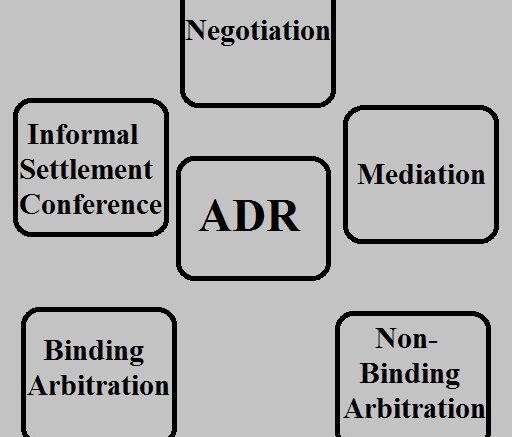For purposes of this article I am assuming any efforts to resolve the problem between the parties before the lawsuit was filed have failed.
So if there is a lawsuit, does there have to be a trial or can the case still be resolved?
The answer to this is simple, yes. Through a variety of methods called “Alternative Dispute Resolution” (ADR) a case can be settled at any time up through and even after a trial.
Informal Methods to Resolve a Lawsuit
Obviously, the easiest way to resolve a case is for the parties to simply get together and work out their differences. If a lawsuit has already been filed it would be a good idea for the parties to write up the terms of any agreement and file it with the court. A Motion to Dismiss should be filed once the agreement has been reached and filed.
The next informal way to settle a case will only work in certain courts. A recent trend is for courts to have magistrates or others trained in dispute resolution to meet with both parties in a very informal setting and attempt to resolve the case. Often it’s just a matter of the neutral magistrate asking each party to state their position and then explain what attempts were made to avoid a lawsuit. As with all of the methods discussed in this article, with one exception, the magistrate cannot order a case settled.
Getting the Court Involved to Settle
If one of the parties believes a case can be resolved but the other party refuses to discuss it then the willing party can file a Motion to Refer Case to Mediation. Almost all judges will order a case to mediate if a request is made by a party and many judges automatically refer all cases anyway. The main drawback to mediation is there is usually a fee required to be paid to the mediator by each party. Fees are usually based on the amount of time the mediation will take, with the mediators usually working in half day increments. After the mediation the mediator does not tell the judge what happened, who would not settle, or why there was not a settlement. Instead, they simply file a letter or report with the judge stating the case and whether the case settled or not.
The advantages to the mediation process are:
- mediation has a success rate of 86% overall,
- a mediated case resolves faster than having a trial,
- there is no appeal from a settlement and thus, no additional costs,
- the stress level is much lower than with a trial,
- it is not always necessary to learn all the rules, law, and statutes involved,
Disadvantages to mediation include:
- there are additional costs since the parties must pay the mediator’s fees,
- usually, in a settlement, neither side is completely satisfied.
Arbitration
Another method of resolving a case is by way of arbitration. While some contracts require arbitration in other cases it must be agreed on by the parties otherwise the judge cannot force an arbitration to occur.
Arbitration is like a trial but less formal. Witnesses can be called, they swear an oath to tell the truth, the Rules of Evidence may or may not apply, and the arbitration is usually held in front of a specially trained arbitrator, often a retired judge.
This method can take two forms, binding arbitration or non-binding arbitration.
Binding arbitration means the arbitrator’s decision is final, the parties cannot decide they do not like the decision and then proceed on to trial in the original court nor can they appeal the decision.
Non-binding arbitration means that if either, or both, of the parties do not like the decision then they can go back to court, proceed with their regular trial preparation and, ultimately, take their case to a judge or jury trial.
The advantage to arbitration is that the case will often be resolved earlier than with a trial and it is a less formal setting making it less stressful for someone representing themselves. However, as with mediation, an arbitrator has fees which have to be paid by the parties.
Summary
Although a lawsuit may have been filed, a case can still be resolved, with or without lawyers, short of a trial.
Alternative Dispute Resolution offers a number of different methods of settling a case including informal settlement conferences, mediation, and binding or non-binding arbitration. All of these methods have advantages and disadvantages which must be carefully considered but attorneys are using all of them successfully every day and if an attorney can do it, so can our readers.


Be the first to comment on "Anatomy of a Lawsuit – Trying to Settle"